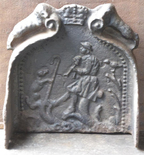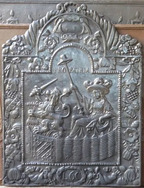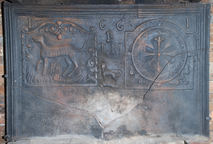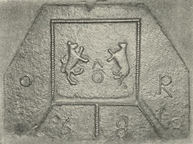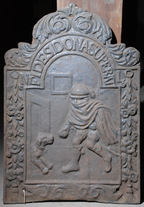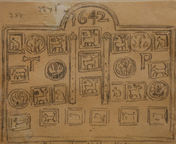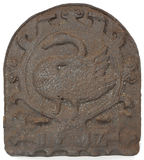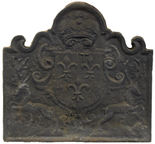-
1128
Description: Quasi-arched shape with forward-facing 'wings', which splay outwards towards the base; the 'wings' curve to follow the shape of the main panel but curl outwards at the top; central panel with pictorial image of, to the right, a shepherd holding a musical pipe, his right foot upon a log, upon which a dog, to the left, sits holding the shepherd's crook; top centre, a crown, on either side of which, on the curled upper parts of the 'wings', is an inward facing sheep.
Notes: Nothing is known about the sources of free-standing firebacks or what prompted their production. Their form is similar but the predominant use of horticultural or arboreal decorative themes, which suggests production within a limited time frame, has in this instance been replaced with a humorous scene. Only a very small number of such castings are known. Depth 210mm
- Decoration tags:
- free-standing (shape)
- none (edging)
- whole carved pattern
- heraldic
- pictorial
- animals
- humans
- plants
- objects
Manufactured: in the late-17th to early-18th century in England.
Current location: not known.
- Attached to series:
- Free-standing firebacks
-
1212
Description: Arched rectangular central panel with bead edging; wickerwork Garden of Holland (Hollandse Tuin) within which is seated a berobed female figure holding a cap of freedom on the end of a long pole; before her is the crowned heraldic lion of the States General of the Netherlands, clutching a sheaf of arrows in its left front paw; above are the words, Pro Patria; arched rectangular border with fillet edging; central cartouche at top, with festoons of fruit, flowers and leaves suspended on each side from ribbons supported by rings; at the bottom, swirled ribbon around an oval compartment bearing the inscription 'L6C'; on top, a central cartouche from which descend a cornucopia on each side of the arch.
Notes: An overtly patriotic theme with symbols of Dutch nationhood; the inscription at the bottom indicates the style of border; other firebacks with the same inscription have the same border; similar inscriptions (e.g. L7C and L8G) indicate different borders.
Inscription: PRO PATRIA / L6C
- Decoration tags:
- 'Dutch' (shape)
- fillet (edging)
- whole carved pattern
- pictorial
- allegorical
- text
- animals
- humans
- plants
- objects
Manufactured: in the late-17th century in the Siegerland area of Germany.
Current location: not known.
- Attached to series:
- 'Dutch' LC/G series
- 'Dutch' Garden of Holland firebacks
-
13
Description: Rectangular; composite: complex (cavetto/cyma recta/ovolo) moulded edging (top and sides), derived from domestic carpentry; two firebacks used as patterns: on the left, rectangular with mirrored floriate scrolled top, simulated overlapping tile edging at sides, with fillet bottom edge, a mythical salamander in the form of a dog with an arrow-shaped tongue, standing among flames, a stapled scroll inside the left and right edges; on the right, arched rectangular with fillet edging indented on the inner side, surrounding a circular clock face with Roman numerals, each interspaced with a bead, and a button outside each quarter, a triangular design of swirled foliage in each bottom spandrel; initials in triad between firebacks; below, stamp formed of a talbot statant guardant upon a wreath; date split: ‘1’s in top corners, ‘6’s above initials; bottom third of fireback plain.
Notes: The talbot crest, which in this instance has been over pressed and shows the shape of the backing, is seen on other firebacks indicating a common source; the 'salamander' fireback (see no. 851) is one of the Stapled Scroll series; composite firebacks (where the impression of one or more other firebacks are used as part of the decoration) are uncommon in England but less so in France.
Inscription: 16 61 / IBM [triad]
- Decoration tags:
- rectangular (shape)
- complex, furniture-derived (edging)
- composite
- individual letters
- individual numbers
- heraldic
- mythological
- text
- animals
- objects
Manufactured: in 1661 in the Weald area of England.
Current location: in private hands, Ardingly, West Sussex, England.
- Attached to series:
- Composite firebacks
- Talbot crest series
-
897
Description: Steeply canted rectangle; no edging; upper centre, square formed of twisted rope lengths inside which are what appear to be two lions passant in pale with a circle and two short sloping lines in inverted V form above; on either side of the square is an O and an R; below the square three lengths of twisted rope extend to the bottom edge, the central one vertically and the the outer two sloping away from the centre; along the bottom is the date, each numeral separated by one of the rope lengths.
Notes: Alleged to be a representation of the arms of the O'Rourke family, who held sway in Cavan and Leitrim, the initials said to be of Owen O'Rourke. Noted in a cottage at Arigna, County Roscommon.
Inscription: O O R / 1 6 8 8
Arms: O'Rourke
- Decoration tags:
- rectangular with canted top corners (shape)
- none (edging)
- simple stamps
- carved stamps
- heraldic
- text
- animals
- objects
Manufactured: in 1688 possibly at Drumshanbo Furnace in the Leitrim area of Ireland.
Current location: not known.
Citation: Lindsay, J. S., 1927, Iron & Brass Implements of the English House (London, The Medici Society).
- Attached to series:
- Miscellaneous stamp firebacks
- Date & initials firebacks
-
844
Description: Arched rectangular central panel; fillet edging; pictorial scene of a cloaked figure, to the right, tempting a dog, to the left, with a tasty morsel; behind are the outlines of a door and window; arched rectangular border with fillet edging, the date along the bottom; down each side, a floral festoon; over the arch, the inscription, the initials split between each side of the main inscription; on top, floral scrolls.
Notes: The inscription translates as 'loyalty above gifts'; some castings omit the initials, NL, indicating that they were a subsequent addition. The illustration is derived from 'The thief and the dog', one of a series of engravings of Aesop's Fables by Wenceslaus Hollar.
Copies of this fireback are known.
Inscription: N / FIDES DONA SUPERAT / L // 1696
- Decoration tags:
- 'Dutch' (shape)
- fillet (edging)
- whole carved pattern
- individual letters
- planklines
- pictorial
- allegorical
- text
- animals
- humans
Manufactured: in 1696 possibly in the Siegerland area of Germany.
Current location: English Heritage Store, Atcham Business Park, Atcham, Shropshire, England.
Museum number: EH ASC 4491 (part of the English Heritage museum group)
- Attached to series:
- 'Dutch' 1696 NL series
-
966
Description: Arched rectangular shape; ovolo moulded edging; date in arch; below arch two parallel, vertical straps, each with a buckle at the top; initials left and right of centre; roughly symmetrical arrangement of four stamps repeated: rectangular stamp with deer three times down centre, one outside each buckle and one beyond each strap end; circular food mould stamp outside centre of each strap, beyond stag stamp outside buckle and at edge beyond strap end; 'rabbit' stamp at edge beyond food mould stamp outside each buckle and outside each strap end; rectangular stamp with 'dog' outside each initial and six times below strap ends.
Notes: The buckles suggest a connection with the Pelham family; the initials may relate to Sir Thomas Pelham, Bt. (1597-1654) who owned and operated ironworks at Waldron in Sussex. From the drawing the seven 'deer' stamps appear to be the same as those seen on two other examples of this fireback. The food mould stamp (centre left and right) appears to be one seen repeated on at least one other fireback. Drawing of a fireback at Huggetts Farm, Waldron, Sussex, by Edward Hughes, of Heathfield, Sussex; J. Starkie Gardner collection, Victoria & Albert Museum, Archive of Art and Design (AAD/2014/8).
Inscription: 1642 / T P
- Decoration tags:
- rectangular with round arch (shape)
- ovolo (edging)
- carved stamps
- whole carved pattern
- individual letters
- text
- animals
- objects
Manufactured: in the mid-17th century probably at Waldron Furnace in the Weald area of England.
Current location: not known.
Citation: Gardner, J. S., 1898, 'Iron Casting in the Weald', Archaeologia, 56, 1, pp. 133-164.
- Attached to series:
- 1642 Pelham series
- Pelham family firebacks
- Food mould stamp firebacks
-
1244
Description: Cavetto-canted arched rectangular shape with rectangular extension panels; cavetto-moulded edging, with astragal on wide fillet edging on the extension panels; central panel, crown, shield and Garter of the Tudor royal arms but with crowned lion and unicorn supporters, all within an undulating vine border; extension panels comprise a single letter (W on left, H on right) above an inward-facing seated squirrel.
Notes: The royal arms are a hybrid of the Tudor and Stuart achievement, quite crudely modelled. The initials and squirrels both relate to the Holte family who lived at Aston Hall, which was built between 1618 and 1623. The difference in the condition of the armorial and the extensions suggest that the armorial was significantly older than the extensions. The bottom 190mm of the fireback is concealed below, behind the grate placed in front of it.
Inscription: W / HONY SOIT QUI MAL Y PENSE / H
Arms: English Tudor royal with Stuart lion and unicorn supporters
- Decoration tags:
- rectangular with canted top corners and round arch (shape)
- cavetto (edging)
- carved stamps
- carved pattern panels
- extension panels
- heraldic
- armorial
- royal
- text
- animals
Manufactured: in the mid- to late-17th century in England.
Current location: Aston Hall, Aston, West Midlands, England.
(part of the Birmingham Museums Trust museum group)
- Attached to series:
- Stuart royal armorial firebacks
-
889
Description: Arched shape; fillet edging; swan within a voided strapwork cartouche; date in Arabic numerals, at bottom, on a broad horizontal fillet.
Notes: Stylistically, of the early 17th century, suggesting the date is 1617, although the third numeral is indistinct. Bonham's sale, Chester, 18 October 2012, lot 384 (£375).
Inscription: 16 1[?]7
- Decoration tags:
- rounded arched (shape)
- fillet (edging)
- whole carved pattern
- heraldic
- architectural
- text
- animals
Manufactured: in 1617 in England.
Current location: not known.
- Attached to series:
- Miscellaneous pattern firebacks
-
1163
Description: Arched; ogee edging; Tudor royal shield, garter, crown and supporters (dragon and greyhound); top left, crowned Tudor rose; top right, crowned portcullis (grid of 6).
Notes: There are several firebacks with the Tudor royal arms that were probably produced in the Spanish Netherlands, perhaps illustrating the association between England and Spain through the marriage of Henry VIII and Katherine of Aragon. The firebacks differ in several small details, such as the form and rotation of the Garter motto, the style of the crown, the positioning of the supporters in relation to the Garter, and the form and size of the crowned rose and portcullis.; the placement of the rose and crown and of the crown above the portcullis suggest that they are stamps impressed over the original moulded design before casting. Bonhams auction, Oxford, 19 Feb 2020, lot 292.
Inscription: HONI SOIT QVI MAL I PENSE
Arms: Tudor royal
- Decoration tags:
- rounded arched (shape)
- cyma reversa/ogee (edging)
- carved stamps
- whole carved pattern
- heraldic
- armorial
- text
- animals
Manufactured: in the mid-16th century possibly in the Wallonia area of Luxemburg.
Current location: not known.
- Attached to series:
- Tudor royal armorial firebacks
- Continental Tudor royal armorial firebacks
-
918
Description: Rectangular with complex quasi-arched rectangular top; ovolo moulded edging; shield with Royal arms of France in a swirled cartouche, initials IT top centre; above, an English crown; below to right and left, a prancing stag.
Notes: The combination of the English crown and French arms is common and may relate to the marriage of Charles I and Princess Henrietta Maria of France in 1625; although the framing of the pattern is very similar to others of the same basic design, the style suggests a different pattern maker. A variant of an otherwise identical fireback, with the addition of the date and initials. Bonhams sale, Chester, 25 July 2013, lot 257.
Copies of this fireback are known.
Inscription: IT / 16 [?]1
Arms: France modern
Manufactured: in the early- to mid-17th century possibly in the Weald area of England.
Current location: not known.
- Attached to series:
- Ornate border series
- Miscellaneous royal firebacks
- Anglo-French armorial firebacks
